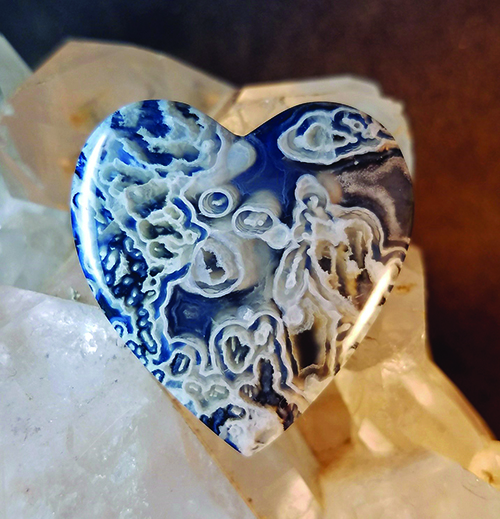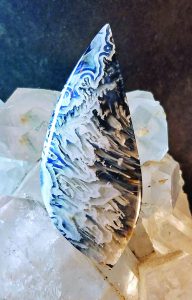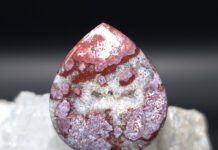
By Russ Kaniuth
Keegan Ranch Tube Agate from Oregon is one of the most highly sought tube agates for lapidary work. The translucent chalcedony with beautiful wispy white tube patterns makes absolutely gorgeous cabochons. Whether cabbed on its own or backed as a doublet, its beauty stands out. This material is growing scarce and is hard to find, but it can be found occasionally at shows or in online auctions.
Start With Slabs
It is best to buy this material in slabs so that you can see clearly what you are getting. If you do buy rough, examine the stone carefully to see which direction the tubes flow. You might need to soak it for an hour or so and scrub it with a brush to see the pattern more definitively. This will allow you to cut in a way to gain the pattern you desire. Most lapidaries tend to cut in a direction that will yield long tube cross-sections, but others cut in the opposite direction for orbicular patterns

Cabbing this material is usually straightforward, but you also have more involved options. For instance, Keegan Ranch Tube Agate is a perfect material for crafting doublets. When backed with a dark base, the clear chalcedony gives the tubes three dimensional effect with great depth.
Historically, most lapidaries have used black basanite as the backing. While this exposes the patterns really well, in recent years others have been using turquoise or other colorful materials for a decidedly different flare. I have personally used labradorite. The colorful rainbow flash shows through the chalcedony very well, and the overlying tube patterns provide a wonderful 3D effect.
I have also used Italian black marble because it has equal hardness with the agate. This is important when making doublets because if backing material is softer than the agate, girdle edges may cut unevenly, leaving an undercut seam at the glue joint.
Double Down on Doublets
Making doublets with this material is easy given that most jeweler-grade epoxies work well. Start by marking the shape you want on the tube agate and trim the shape, leaving a little space around the edges. Then apply epoxy to a slightly larger piece of backing. Spread the epoxy lightly so as not to create bubbles. Then apply the tube agate gently.
Give a slight swirl while pressing firmly to the backing. This will help spread the epoxy out to all edges in an even manner. Give the material a day to cure completely. Then take your material back to the trim saw and trim off any excess backing, and you will be ready for cabbing.
The cabbing process is easy if you used a backing approximately 3 to 4 mm thick and your tube agate was approximately 2 mm thick. Start on the 80 grit wheel and round the agate edges down to the backing material and start making your dome. From this point, you cab in the traditional way as with any other agate. As you progress and thin down the top layer, the backing color will reveal ever greater depth, clearly revealing why Keegan Ranch Tube Agate is so sought after by lapidary artists.
Author: Russ Kaniuth
 Is the owner of Sunset Ridge Lapidary Arts and the cofounder of the Cabs and Slabs Facebook group.
Is the owner of Sunset Ridge Lapidary Arts and the cofounder of the Cabs and Slabs Facebook group.
View more of his work at www.sunsetridgelapidary.com.














